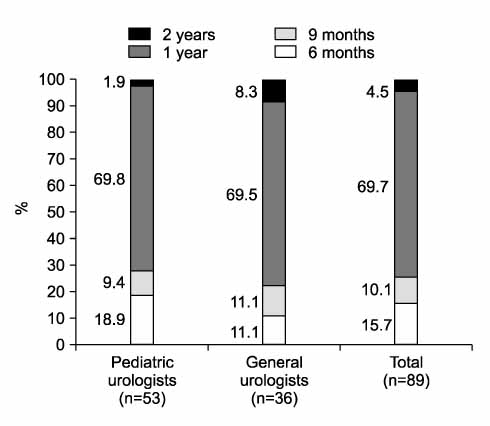Korean J Urol.
2009 Feb;50(2):169-178.
Comprehension and Practice Patterns Toward Cryptorchidism in Korean Urologists
- Affiliations
-
- 1Department of Urology, Kangwon National University School of Medicine, Chuncheon, Korea.
- 2Department of Urology, Asan Medical Center, University of Ulsan College of Medicine, Seoul, Korea.
- 3Department of Urology, Keimyung University School of Medicine, Daegu, Korea.
- 4Department of Urology, Masan Samsung Hospital, Sungkyunkwan University School of Medicine, Masan, Korea. dsryumd@paran.com
Abstract
- PURPOSE
We evaluated the practice patterns of urologists in Korea regarding the diagnosis and management of cryptorchidism.
MATERIALS AND METHODS
Self-completed questionnaires that consisted of 15 items concerning the diagnosis and treatment of cryptorchidism were distributed via letters or e-mail to 167 urologists who practiced in training hospitals in Korea. Responses were collected and analyzed statistically.
RESULTS
Responses were received from 89 urologists (response rate was 53.5%). Most of the urologists (96%) recommended that cryptorchidism be treated at the age of 1 year or before. In the case of postpubertal cryptorchidism, 72% of Korean urologists preferred orchiopexy first because of cosmesis (42%) and early detection of testicular cancer (38%). Sixty-five percent of all urologists preferred surgical correction of a retractile testis at the time of diagnosis or when the condition persisted until school age or puberty. Pediatric urologists were more conservative in terms of management of a retractile testis than were general urologists (p=0.009). To detect hidden testes in nonpalpable cryptorchidism, most urologists (92%) performed imaging studies, whereas only 39% of urologists performed laparoscopy.
CONCLUSIONS
Korean urologists who practice in the training hospitals have a high level of understanding of the management of cryptorchidism. However, some differences of opinion exist in the diagnosis and treatment of nonpalpable undescended testis and retractile testis. These results can be used as baseline data for establishing future diagnosis and treatment guidelines for cryptorchidism.
Keyword
MeSH Terms
Figure
Reference
-
1. Scorer CG. The descent of the testis. Arch Dis Child. 1964. 39:605–609.2. John Radcliffe Hospital Cryptorchidism Study Group. Cryptorchidism: a prospective study of 7,500 consecutive male births, 1984-8. Arch Dis Child. 1992. 67:892–899.3. The Korean Urological Association. Data on statistics of management in resident training hospital in the Korean Urological Association: 1984-2002. 2004. Seoul: Eui-Hak Publishing & Printing Co.;84–96.4. Schneck FX, Bellinger MF. Wein AJ, Kavoussi LR, Novick AC, Partin AW, Peters CA, editors. Abnormalities of the testes and scrotum and their surgical management. Campbell-Walsh urology. 2007. 9th ed. Philadelphia: Saunders;3761–3798.5. Kim TK, Lee SD, Cho BM, Kim SY, Kim JS. Report on the patient parents' understanding and the pediatricians' understanding of cryptorchidism: the optimal time for surgical correction. Korean J Urol. 2005. 46:1290–1301.6. Chilvers C, Dudley NE, Gough MH, Jackson MB, Pike MC. Undescended testis: the effect of treatment and subsequent risk of subfertility and malignancy. J Pediatr Surg. 1986. 21:691–696.7. Mengel W, Wronecki K, Schroeder J, Zimmermann FA. Histopathology of the cryptorchid testis. Urol Clin North Am. 1982. 9:331–338.8. Ryu DS. Diagnosis and management of cryptorchidism. J Korean Med Assoc. 2008. 51:643–650.9. Lee JH, Han JJ, Song SY, Park KH. Histological changes of the cryptorchid testis according to the age. Korean J Urol. 2002. 43:631–637.10. Park JW, Kim KS. Incidence, risk factors and spontaneous descent of cryptorchidism. Korean J Urol. 2003. 44:1203–1207.11. Kogan SJ, Tennenbaum S, Gill B, Reda E, Levitt SB. Efficacy of orchiopexy by patient age 1 year for cryptorchidism. J Urol. 1990. 144:508–509.12. King LR. Optimal treatment of children with undescended testes. J Urol. 1984. 131:734–735.13. Walsh TJ, Dall'Era MA, Croughan MS, Carroll PR, Turek PJ. Prepubertal orchiopexy for cryptorchidism may be associated with lower risk of testicular cancer. J Urol. 2007. 178:1440–1446.14. Pettersson A, Richiardi L, Nordenskjold A, Kaijser M, Akre O. Age at surgery for undescended testis and risk of testicular cancer. N Engl J Med. 2007. 356:1835–1841.15. Capello SA, Giorgi LJ Jr, Kogan BA. Orchiopexy practice patterns in New York State from 1984 to 2002. J Urol. 2006. 176:1180–1183.16. Oh J, Landman J, Evers A, Yan Y, Kibel AS. Management of the postpubertal patient with cryptorchidism: an updated analysis. J Urol. 2002. 167:1329–1333.17. Kolon TF, Patel RP, Huff DS. Cryptorchidism: diagnosis, treatment, and long-term prognosis. Urol Clin North Am. 2004. 31:469–480.18. Han SW, Lee T, Kim JH, Choi SK, Cho NH, Han JY. Pathological difference between retractile and cryptorchid testes. J Urol. 1999. 162:878–880.19. Elder JS. Ultrasonography is unnecessary in evaluating boys with a nonpalpable testis. Pediatrics. 2002. 110:748–751.20. Hrebinko RL, Bellinger MF. The limited role of imaging techniques in managing children with undescended testes. J Urol. 1993. 150:458–460.21. Park SY, Park KH. Guideline for the surgical diagnosis and treatment of nonpalpable testis based on experiences with laparoscopic procedure. Korean J Urol. 2006. 47:762–768.22. Snodgrass WT, Yucel S, Ziada A. Scrotal exploration for unilateral nonpalpable testis. J Urol. 2007. 178:1718–1721.
- Full Text Links
- Actions
-
Cited
- CITED
-
- Close
- Share
- Similar articles
-
- Comprehension and Practice Patterns of Korean Urologists for Retractile and Gliding Testes
- Ultrastructure of the Rat Testes in Experimental Cryptorchidism
- Korean Urologist's View of Practice Patterns in Diagnosis and Management of Benign Prostatic Hyperplasia: A Nationwide Survey
- Patterns in the Diagnosis and Management of Benign Prostatic Hyperplasia in a Country that does not have Country-Specific Clinical Practice Guidelines
- 5 cases of the Cryptorchidism Treated with Hormonal Therapy (H.C.G.)


